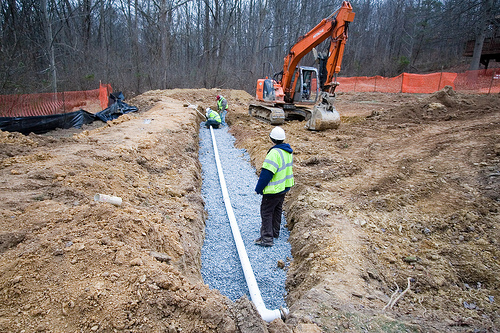Part 1 of this blog series summarized recent studies in Minnesota, Connecticut, New Hampshire, and King City, Ontario, which all found that the difference between summer and winter performance of bioretention systems is not substantial, even on sites with severe winters. Now that we know that, how do we go about maximizing bioretention performance in cold climates?
Remember that a key discovery to optimize bioretention performance in cold climates is that the type of frost seems to influence bioretention performance more than the mere presence or depth of frost (LeFevre et al 2009). As Roseen et al (2009) note from their research in New Hampshire, “frost penetration does not necessarily equate to filter media permeability; frozen media may still have significant porosity and permeability.” The Minnesota study found that when UNSATURATED soils reach freezing temperatures, infiltration rates can remain very high. However, when SATURATED soils reach freezing temperatures, infiltration is restricted (LeFevre et al 2009).
As a result of this, several techniques to optimize bioretention practices for cold climate performance aim to keep bioretention soils unsaturated as freezing temperatures approach. A few example recommendations from the Minnesota study (Davidson et al, 2008 and LeFevre et al, 2009) study are summarized below.
- Use bioretention soils with a low percent of fines, i.e. high infiltration rates
- Field test prior to installation to confirm the design is appropriate, and allow for field adjustments if needed
- Avoid reducing infiltration capability during installation, e.g. divert stormwater until all disturbed soils up gradient of the cell have been stabilized and impervious surfaces are cleared of construction sediments.
- Install an underdrain with an accessible cap or valve at its outlet to allow operation as either an infiltration system or a filtration system. The valve can be opened to allow early-fall draw down in preparation for freezing weather. As the Minnesota study suggests, during cold winters, “it is better to…have a functional filtration system then a non-functional (frozen) infiltration system” (Davidson et al 2008).
These are good guidelines to keep in mind if you’re designing with bioretention in mind in climates that regularly experience freezing temperatures. Properly implemented, they should help keep the site functioning as intended, even throughout the winter.
References
Davidson, J.D., M. Isensee, C. Coudron, T. Bistodeau, N.J. LeFevre, and G. Oberts. 2008. Recommendations to Optimize Hydrologic Bioretention Performance for Cold Climates. WERF Project 04-DEC-13SG.
Dietz, M.E. and Clausen, J.C. 2006. Saturation to improve pollutant retention in a rain garden. Environmental Science and Technology. Vol. 40. No. 4. pp. 1335-1340.
LeFevre, N.J., J. D. Davidson, and G. L. Oberts. 2009. Bioretention of Simulated Snowmelt: Cold Climate Performance and Design Criteria. Proceedings of the 14th Conference on Cold Regions Engineering.
Roseen, R.M., Ballestro, T.P., Houle, J.J., Avelleneda, P., Briggs, J., Fowler, G., and Wildey, R. 2009. Seasonal Performance Variations for Storm-Water Management Systems in Cold Climate Conditions. Journal of Environmental Engineering. Vol. 135. No. 3. pp. 128-137.
Toronto and Region Conservation (TRCA). 2008. Performance Evaluation of Permeable Pavement and a Bioretention Swale, Seneca College, King City, Ontario. Prepared under the Sustainable Technologies Evaluation Program (STEP). Toronto, Ontario.
Toronto and Region Conservation. 2009. Review of the Science and Practice of Stormwater Infiltration in Cold Climates. 2009. Downloaded December 2010.






Leave Your Comment